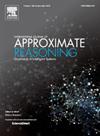Fuzzy time series analysis: Expanding the scope with fuzzy numbers
IF 3
3区 计算机科学
Q2 COMPUTER SCIENCE, ARTIFICIAL INTELLIGENCE
引用次数: 0
Abstract
This article delves into the process of fuzzifying time series, which entails converting a conventional time series into a time-indexed sequence of fuzzy numbers. The focus lies on the well-established practice of fuzzifying time series when a predefined degree of uncertainty is known, employing fuzzy numbers to quantify volatility or vagueness. To address practical challenges associated with volatility or vagueness quantification, we introduce the concept of informed time series. An algorithm is proposed to derive fuzzy time series, and findings include the examination of structural breaks within the realm of fuzzy time series. Additionally, this article underscores the significance of employing topological tools in the analysis of fuzzy time series, accentuating the role of these tools in extracting insights and unraveling intricate relationships within the data.
模糊时间序列分析:用模糊数扩大分析范围
本文将深入研究模糊化时间序列的过程,这需要将传统的时间序列转换为时间索引的模糊数序列。重点在于当预定义的不确定性程度已知时,模糊化时间序列的成熟实践,使用模糊数来量化波动性或模糊性。为了解决与波动性或模糊性量化相关的实际挑战,我们引入了知情时间序列的概念。提出了一种推导模糊时间序列的算法,研究结果包括对模糊时间序列领域内结构断裂的检验。此外,本文强调了在模糊时间序列分析中使用拓扑工具的重要性,强调了这些工具在提取见解和揭示数据中复杂关系方面的作用。
本文章由计算机程序翻译,如有差异,请以英文原文为准。
求助全文
约1分钟内获得全文
求助全文
来源期刊

International Journal of Approximate Reasoning
工程技术-计算机:人工智能
CiteScore
6.90
自引率
12.80%
发文量
170
审稿时长
67 days
期刊介绍:
The International Journal of Approximate Reasoning is intended to serve as a forum for the treatment of imprecision and uncertainty in Artificial and Computational Intelligence, covering both the foundations of uncertainty theories, and the design of intelligent systems for scientific and engineering applications. It publishes high-quality research papers describing theoretical developments or innovative applications, as well as review articles on topics of general interest.
Relevant topics include, but are not limited to, probabilistic reasoning and Bayesian networks, imprecise probabilities, random sets, belief functions (Dempster-Shafer theory), possibility theory, fuzzy sets, rough sets, decision theory, non-additive measures and integrals, qualitative reasoning about uncertainty, comparative probability orderings, game-theoretic probability, default reasoning, nonstandard logics, argumentation systems, inconsistency tolerant reasoning, elicitation techniques, philosophical foundations and psychological models of uncertain reasoning.
Domains of application for uncertain reasoning systems include risk analysis and assessment, information retrieval and database design, information fusion, machine learning, data and web mining, computer vision, image and signal processing, intelligent data analysis, statistics, multi-agent systems, etc.
 求助内容:
求助内容: 应助结果提醒方式:
应助结果提醒方式:


